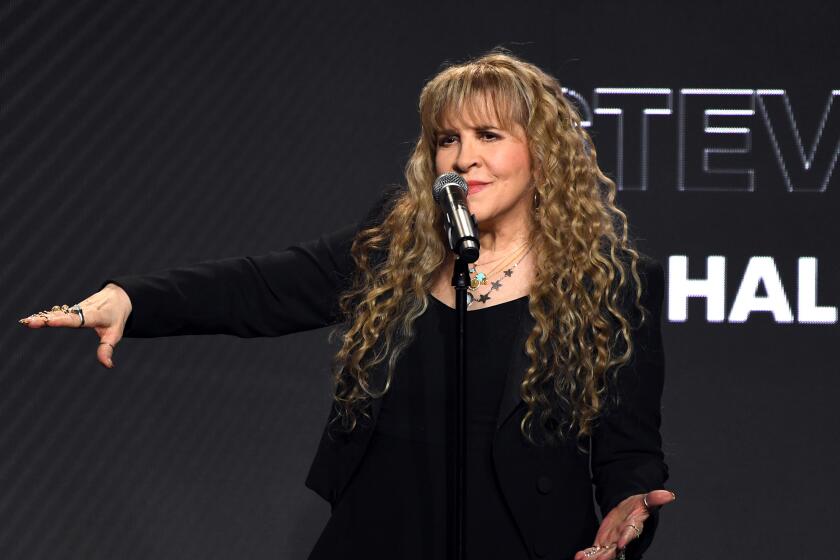The Essential Guide to Contemporary Rap
- Share via
Fat gold chains, expensive track suits and major-league egos--once the stereotypical trademarks of rap music--are rumbling in the face of a fresh ainflux of creative young rhymers whose styles are as varied as their birthplaces. They flaunt humor, intelligence and style without losing a step on the dance floor.
Here are 10 introductions to what’s happening now in rap--in order of preference:
De La Soul’s “Three Feet High and Rising” (Tommy Boy)--This Long Island trio launches its self-proclaimed “Daisy Age” with this madcap masterpiece. Throwing together samples of early ‘70s soul, imaginative dance-inducing drum beats and even Steely Dan riffs in a kind of psychedelic collage, rhymers Pos and Dove deliver smart, sometimes cryptic verses about everything from gardening to sex.
The Jungle Brothers’ “Straight Out the Jungle” (Idlers)--From romance to racism, the JB’s tell it like it is with a charismatic and suave funkiness. “Behind the Bush” is a lush, seductive groove that rivals Marvin Gaye’s most persuasive efforts and “Black Is Black” discourses on black unity over a seriously funky soul beat.
Tone Loc’s “Loc’ed After Dark” (Delicious Vinyl)--Imagine the shock in New York: The biggest-selling rap single ever (the irresistibly danceable “Wild Thing”) comes out of Los Angeles. The follow-up, the equally infectious “Funky Cold Medina,” is also rocketing up the charts.
Boogie Down Productions’ “By All Means Necessary” (Jive/RCA)--BDP’s Chris Parker, known as KRS-One “teaches but never preaches,” with themes of positivity and non-violence. The single “Stop the Violence” initiated a new era of community involvement for fellow rappers, and rocked dance floors and airwaves throughout urban America, while “My Philosophy” lays down some South Bronx-style truths.
Shinehead’s “Unity” (Elektra)--Shinehead was born in Jamaica and bred in the Bronx, personifying a newly emerging hip-hop style that blends Caribbean “toasting,” an early ‘60s rap predecessor, with New York-style beats. “Who The Cap Fits” tips its hat to Bob Marley and “Unity” borrows a chorus section from the Beatles’ “Come Together.”
Public Enemy’s “It Takes a Nation of Millions to Hold Us Back” (Def Jam/Columbia)--Public Enemy took the rap scene by storm with their radical political line and hard-driving beats. Selling hundreds of thousands of records with little or no radio airplay, rhymer Chuck D and sidekick Flavor Flav have their fingers on the pulse of urban youth, reflecting rage, rhythm and discontent.
N.W.A’s “Straight Outta Compton” (Ruthless)--This five-man posse from Compton spins some shockingly intense tales of life in the “panic zone.” Songs like “Gangsta Gangsta” and “Dopeman” may make parents squirm, but the group does present a steely-eyed vision of reality that’s a blast to dance to.
Eric B. & Rakim’s “Follow The Leader” (Uni/MCA)--In terms of pure technique, all the rap world looks up to the smoothly sophisticated style of Rakim. This latest album finds the two at their best with superbly produced and performed selections like “Follow the Leader,” “Lyrics of Fury,” and “The R.”
Gang Starr’s “No More Mr. Nice Guy” (Wild Pitch)--The son of a municipal court judge, this New Yorker lays down the law for kids who see rap as “black America’s radio station.” Songs such as “Knowledge,” “Positivity,” and “Cause and Effect” are more concerned with educating and relating than with egos and bragging; using hot soul-flavored dance beats and infusions of jazz.
The Wee Papa Girls’ “The Beat, the Rhyme, the Noise” (Jive/RCA)--The fashionable English duo pioneered the use of disco-style “house” music beats in rap with “Heat It Up” and also flaunt reggae, funk, and even acid styles. Producer Teddy Riley, who broke acts like Bobby Brown and Keith Sweat, produces the girls’ rap version of the George Michael hit “Faith,” which was a major hit overseas. Disco rap? Why not?
More to Read
The biggest entertainment stories
Get our big stories about Hollywood, film, television, music, arts, culture and more right in your inbox as soon as they publish.
You may occasionally receive promotional content from the Los Angeles Times.










